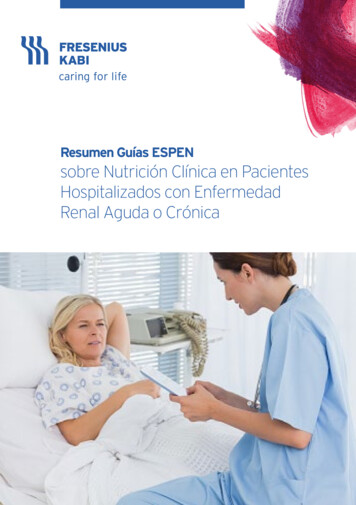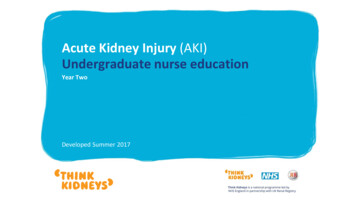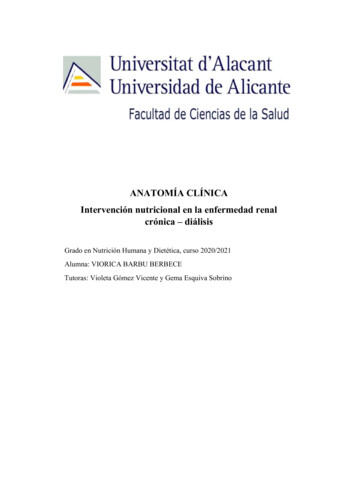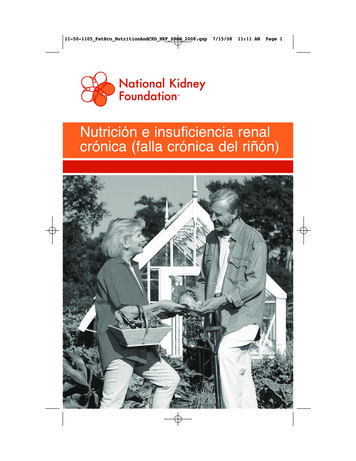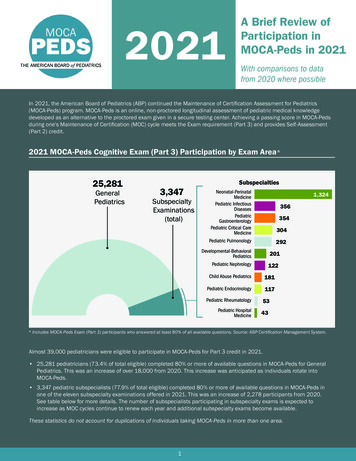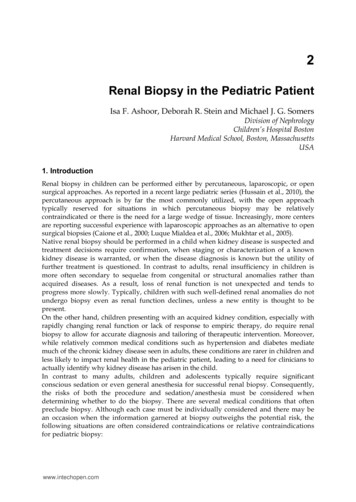
Transcription
2Renal Biopsy in the Pediatric PatientIsa F. Ashoor, Deborah R. Stein and Michael J. G. SomersDivision of NephrologyChildren’s Hospital BostonHarvard Medical School, Boston, MassachusettsUSA1. IntroductionRenal biopsy in children can be performed either by percutaneous, laparoscopic, or opensurgical approaches. As reported in a recent large pediatric series (Hussain et al., 2010), thepercutaneous approach is by far the most commonly utilized, with the open approachtypically reserved for situations in which percutaneous biopsy may be relativelycontraindicated or there is the need for a large wedge of tissue. Increasingly, more centersare reporting successful experience with laparoscopic approaches as an alternative to opensurgical biopsies (Caione et al., 2000; Luque Mialdea et al., 2006; Mukhtar et al., 2005).Native renal biopsy should be performed in a child when kidney disease is suspected andtreatment decisions require confirmation, when staging or characterization of a knownkidney disease is warranted, or when the disease diagnosis is known but the utility offurther treatment is questioned. In contrast to adults, renal insufficiency in children ismore often secondary to sequelae from congenital or structural anomalies rather thanacquired diseases. As a result, loss of renal function is not unexpected and tends toprogress more slowly. Typically, children with such well-defined renal anomalies do notundergo biopsy even as renal function declines, unless a new entity is thought to bepresent.On the other hand, children presenting with an acquired kidney condition, especially withrapidly changing renal function or lack of response to empiric therapy, do require renalbiopsy to allow for accurate diagnosis and tailoring of therapeutic intervention. Moreover,while relatively common medical conditions such as hypertension and diabetes mediatemuch of the chronic kidney disease seen in adults, these conditions are rarer in children andless likely to impact renal health in the pediatric patient, leading to a need for clinicians toactually identify why kidney disease has arisen in the child.In contrast to many adults, children and adolescents typically require significantconscious sedation or even general anesthesia for successful renal biopsy. Consequently,the risks of both the procedure and sedation/anesthesia must be considered whendetermining whether to do the biopsy. There are several medical conditions that oftenpreclude biopsy. Although each case must be individually considered and there may bean occasion when the information garnered at biopsy outweighs the potential risk, thefollowing situations are often considered contraindications or relative contraindicationsfor pediatric biopsy:www.intechopen.com
18Topics in Renal Biopsy and PathologyContraindications for biopsy:Severe bleeding disorders such as hemophiliaKnown abdominal malignancyMultiple renal cysts or renal tumor preventing sampling of renal parenchymaCompromised skin or skin infection overlying biopsy entry siteUncontrolled hypertension, increasing the risk of post-operative bleedingRelative Contraindications:Massive ascitesSevere hydronephrosisWhile some have challenged the safety of performing renal biopsy in a child with a solitarykidney, current complication rates have decreased to such a degree that, if warranted fordiagnostic reasons and if being performed by experienced clinicians utilizing medicalimaging to visualize the kidney during biopsy, this is generally not considered to be acontraindication.2. Nuts and bolts: Logistics of planning and preparation for the biopsyprocedureIf no ultrasound has been obtained in the past or if there is concern that there may have beenan interval change in the kidney or urinary tract anatomy since the last imaging study, arenal ultrasound is performed to assess for anomalies such as hydronephrosis, to confirmlocation and number of kidneys, and to assess renal size prior to the biopsy. The point of theultrasound is to identify any anatomic reason why biopsy would be contraindicated or thatwould alter the approach to the biopsy.A complete blood count (CBC), coagulation panel including prothrombin time (PT) andpartial thromboplastin time (PTT), as well as a sample for type and screen to be held in theblood bank are obtained, typically within 72 hours of the procedure. The CBC allowsbaseline hematologic parameters to be ascertained in case there is concern regardingbleeding or infection post-procedure and also confirms an acceptable platelet count prior toan invasive procedure. The PT/PTT identifies any tendency toward a coagulopathy thatmay increase the chances of a bleeding complication. Although transfusion post-biopsy israre, having a blood type and screen in the blood bank will expedite this process if it isnecessary, and especially if it is urgently required.Informed consent is obtained from either the parent/guardian or the patient if the patient isof legal age. The consent process must include explaining the risks of the procedure,however rare, including bleeding, infection, and the potential need for surgery to controlbleeding or perform nephrectomy. In children less than 18 years of age who are cognitivelycapable of understanding the rationale for the biopsy procedure, in addition to informedconsent from the parent or legal guardian, there is utility in obtaining assent from the child.This documents that the patient was also involved in the decision to proceed with thebiopsy and underscores the need to keep the patient involved in a developmentallyappropriate fashion with the process.Prior to the biopsy, the patient will need to fast for some period of time, depending onwhether sedation or anesthesia is being utilized and institutional protocols. Most childrenshould tolerate this period of time without the need for supplemental intravenoushydration, but individual circumstance and clinical status must be reviewed to determine ifthe usual period of fasting is likely to cause any untoward consequence; for instance, a childwww.intechopen.com
Renal Biopsy in the Pediatric Patient19with diabetes insipidus or a child with a severe urinary concentrating defect would requirespecial hydration plans.3. Nuts and bolts: Sedation or anesthesia for the pediatric renal biopsyLocal standards and individual clinician preference have the greatest impact on the type ofsedation or anesthesia for pediatric patients undergoing percutaneous renal biopsy. Theoverwhelming majority of children are offered intravenous conscious sedation or some sortof general anesthesia, with very few patients declining such measures and opting for localanesthesia injected at the biopsy site alone. In rare cases of children with seriouscontraindication or objection to sedation or anesthesia, ‘’verbal sedation’’ has been used,with the child talked through the procedure with the help of a child life specialist trained inthis approach (Hussain et al., 2003).Case series from North American centers show that general anesthesia is most oftenreserved for infants or very small children where lack of cooperation during the procedureis a concern as well as in children whose airways may be at risk with sedation alone (Birk etal., 2007; Simckes et al., 2000; Sweeney et al., 2006). This approach is not necessarily the caseworldwide and, in fact, a recent audit in the United Kingdom (Hussain et al., 2010) showed6 of 11 centers routinely using general anesthesia for pediatric kidney biopsies.Intravenous ‘’conscious’’ sedation, sometimes termed ‘’deep’’ procedural sedation, is usuallyadministered by a nurse or physician who has acquired expertise in various sedationtechniques and certification in pediatric advanced life support (Cravero et al., 2006; Mason etal., 2009). The patients should receive continuous cardiorespiratory monitoring throughout theprocedure. A variety of agents may be utilized and the protocols are institution specific ordependent on local resources.Our institution has successfully employed a radiologist-supervised ketamine sedation protocolfor many solid organ biopsies (Mason et al., 2009). In this protocol, children receive an IVKetamine bolus (2 mg/kg) over a 5-minute period with concomitant administration of 0.005mg/kg of IV glycopyrolate. The bolus of ketamine is immediately followed by a continuousinfusion of 25-150 mcg/kg/min of ketamine for the duration of the procedure. Patients olderthan 5 years also receive 0.1 mg/kg of midazolam hydrochloride (maximum 3mg) before theinitial bolus of ketamine. There have been no major adverse events reported with this protocoland both patient and family satisfaction rates have been high.Other published sedation protocols employ a combination of meperidine (1 mg/kg–maximum 50 mg) and diazepam (0.2-0.4 mg/kg), with ketamine reserved for additionalsedation if necessary (Hussain et al., 2003); midazolam 0.1 mg/kg with additional ketmainewhere required (Mahajan et al., 2010); or intravenous propofol (1 mg/kg/dose titrated toeffect) and fentanyl (1 µg/kg/dose) (Birk et al., 2007). Again, local practice and clinicianfamiliarity and expertise with certain medications tend to influence the type of sedationprovided most successfully and is more critical than the use of any specific medication orcombination of medications.Local anesthesia may be achieved by applying a topical anesthetic cream (EMLA, lidocaine2.5% and pritocaine 2.5% or Ametop tetracaine 4%) (Hussain et al., 2003) or local infiltrationwith 1% lidocaine. At our center, for local infiltration with lidocaine, 9 mls of lidocaineare mixed with 1 ml of 8.4% sodium bicarbonate; this approach seems to decreasecomplaints of burning at the site of infiltration, and this is employed regardless of the typeof sedation utilized.www.intechopen.com
20Topics in Renal Biopsy and PathologyThe majority of percutaneous renal biopsies performed under sedation are done outside theoperating room, usually in an interventional radiology suite, a procedure area with access toultrasound imaging, or in ward treatment rooms (Davis et al., 1998; Hussain et al., 2003;Mason et al., 2009). Although there were initial concerns about providing sedation in suchsettings for invasive procedures, our own experience and that of others have shown fewsafety concerns. The Pediatric Sedation Research Consortium reported a large series of30,037 sedation encounters from 26 centers, with data submitted on a variety of pediatricprocedures performed under sedation or anesthesia outside the operating room (Cravero etal., 2006). This study demonstrated the overall safety of such procedures, with no deathsand only one cardiopulmonary resuscitation event. The most commonly encounteredadverse event in this cohort was more than 30 seconds of oxygen desaturation to less than90% by transcutaneous monitoring, and this only occurred in 1.5% of cases. Needless to say,the safety and success of such programs depend on consistently following well-developedprotocols, the presence of certified providers throughout the procedure, and readilyavailable anesthesia services to handle unexpected complications.4. Nuts and bolts: Performing the renal biopsyAs discussed above, institutional practice and resources often guide the location forpediatric biopsies. For instance, in our center, biopsies are performed in an InterventionalRadiology suite with either nurses providing conscious sedation by protocol or PediatricAnesthesiologists providing general anesthesia. The use of sedation versus anesthesiatypically depends on the age of the patient, developmental and emotional factors, and anyco-morbid medical conditions. For instance, a very young child with nephrotic syndromeand significant volume overload will likely warrant general anesthesia whereas a matureadolescent undergoing a transplant biopsy may need little other than local anesthesia overthe biopsy site.Biopsies are performed under sterile conditions. As a result, it is important for theindividual performing the biopsy to follow standard protocol for a sterile invasiveprocedure including aseptic technique and wearing appropriate gowns, gloves, masks, andeye protection.Obtaining an adequate sample is crucial for any renal biopsy, but is even more imperative inchildren undergoing biopsy where the logistics of the procedure may be more complicated.Availability of a dissecting microscope to view each core obtained to assess tissue adequacyis extremely useful to guide the number of cores needed. Presence of either a pathologist ornephrologist experienced in identifying renal tissue under dissecting microscope isobviously essential and should allow some estimation of tissue adequacy.For a native renal biopsy, the child is placed in a prone position and typically the left kidneyis imaged to discern an acceptable biopsy site. In a transplant patient, the child will besupine and the area immediately over the allograft is imaged. The skin overlying the areamost appropriate for biopsy needle introduction is marked during this process. Generally, asite in the lower pole of the kidney is selected, away from the renal hilum and large vessels.At this point, prior to proceeding further with the procedure, a pause or “time-out” isworthwhile, with the individual performing the procedure reviewing aloud the patient’sname, medical diagnosis, planned procedure including site of biopsy, and confirming thatinformed consent has been obtained. All others in the procedure area should then verballyidentify themselves and their role in the procedure, for instance “Jane Jones, RN performingwww.intechopen.com
Renal Biopsy in the Pediatric Patient21sedation” or “John Smith, attending radiologist” so that there is both acknowledgedconsensus of the procedure to be done by all involved and understanding of the specificroles of all the individuals present in the area.The biopsy area is cleaned thoroughly with a betadine solution, and all areas outside thesterile field are covered with sterile drapes. A local anesthetic such as lidocaine is injected atthe marked skin site. An initial wheal is made and then deeper infiltration performed,following the anticipated path of the biopsy needle. A superficial dermatotomy is made overthe wheal, and the biopsy needle is advanced through this area.Typically, most pediatric renal biopsies are now done with ultrasound guidance. If desired,this allows use of a needle guide that helps to position the path of the biopsy needle alongthe desired biopsy tract. It also allows for continuous monitoring of the position of theneedle during the procedure and allows for ready identification of structures such as bowelor large vessels that must be avoided. Optimally, the individual performing the biopsy hasbeen trained in biopsy sonography as well, so that the same individual is controlling theimaging and the needle placement; otherwise, there needs to be continuous communicationbetween the individual advancing the biopsy needle and the sonographer to be sure thatboth agree as to the needle position and the target.Local practice and available resources will determine the biopsy devices and needles used,most of which are readily available from medical vendors. For most percutaneous pediatricrenal biopsies at our center, we use an 18-gauge needle and an automated biopsy device or“gun” that is loaded with the needle. The desired “throw” -- or length of the biopsy needlethat gets propelled into the kidney when the device is engaged -- depends on the size of thechild and the size of the kidney being biopsied. For most children, a throw of approximately2 centimeters allows for a safe biopsy with sufficient tissue but, in especially young childrenor with small kidneys, a shorter throw may be needed to avoid the renal hilum or othersurrounding structures.The needle is advanced to the selected site in the lower pole renal cortex under continuousultrasound guidance. Once the needle reaches the renal capsule, it is advanced slightlyfurther to enter kidney tissue. The biopsy device is then “fired” which allows the innerhollow-core biopsy needle to deploy, cutting a piece of kidney tissue. The cutting needle isthen automatically ensheathed by an outer protective core. The entire biopsy needle deviceis withdrawn from the kidney and the protective sheath withdrawn to expose the tissuecore. The biopsy sample is carefully transferred onto a saline-soaked gauze by rolling theneedle onto the gauze, and then the core is examined by the pathologist or nephrologistunder a dissecting microscope for quick estimation of tissue adequacy. During this timefollowing needle extraction, the physician performing the biopsy or another designeeapplies pressure to the biopsy site.This procedure is repeated until adequate renal tissue has been obtained for the biopsyindication, depending on the patient’s medical condition and the studies to be performed onthe tissue. Typically, for native kidney biopsies, we obtain three cores of tissue to allow forsufficient tissue for light microscopy, immunofluorescence, and electron microscopy. Fortransplant biopsies, two cores are generally obtained since fewer studies are usually done.As always, the size and adequacy of tissue cores obtained will specifically define thenumber of cores needed for any patient. If adequate tissue is not obtained after three to fivepasses of the needle, then there must be consideration of the risk of ongoing passes into thekidney versus the benefits of obtaining more kidney tissue at this point in time.www.intechopen.com
22Topics in Renal Biopsy and PathologyAt completion of the entire biopsy procedure, pressure is applied externally over the biopsysite for a minimum of 5 minutes. A post-biopsy ultrasound with Doppler imaging is thenperformed to evaluate for any hematoma or active bleeding. If bleeding is observed,pressure is maintained until there is evidence of stable imaging with no expandinghematoma or determination is made that there needs to be some other intervention. Thedermatotomy site is covered with a sterile dressing that may be removed the following day.This dressing is observed for any bleeding or drainage while it is in place.5. Open renal biopsy in childrenRarely, an open renal biopsy is appropriate in children. Common indications for open renalbiopsy are listed in Table One. Some clinical scenarios where open biopsy is more commoninclude when attempts at a percutaneous biopsy have failed, when a wedge resection isrequired for pathologic diagnosis, or when there is a bleeding disorder but the biopsy isparamount to treatment decisions. Open biopsy is performed typically by a general surgeon,urologist, or transplant surgeon in an operating room. Open renal biopsy will usually resultin exposure to general anesthesia or more prolonged sedation with longer post-procedurerecovery times, hence increasing health care delivery costs. Failed percutaneous renal biopsyPercutaneous renal biopsy deemed unsafe: Uncontrolled hypertension Bleeding disorderSolitary native kidney with specific concerns for percutaneous approachAnatomic abnormalities complicating percutaneous approach: Horseshoe kidney Pelvic kidneyIntraperitoneal renal allograft with specific concerns for percutaneous approachDonor implantation biopsy at time of transplantBiopsy performed concurrent with other surgical intra-abdominal procedureMorbid obesityTable 1. Common Indications for Open Renal BiopsyThere may be center-specific variation in the use of open biopsy depending on localexperience and expertise. Similarly, there may be changes in local practice regarding specificclinical scenarios that may come to decrease the need for open renal biopsy. For instance,several centers have published their experiences transitioning from open to percutaneousbiopsies of solitary kidneys and transperitoneal allografts (Mendelssohn & Cole, 1995;Vidhun et al., 2003). In cases that may be considered higher risk for percutaneous approach,most clinicians think it judicious to pay special attention to coagulation parameters, bloodpressures and serum creatinine in determining the optimal approach for renal biopsy (Daviset al., 1998; Simckes et al., 2000). Similarly, in situations where a clinician is performing ahigher risk percutaneous biopsy, it would be warranted to ensure in advance that there isavailability of interventional radiology or surgical support services for unexpectedcomplications.www.intechopen.com
Renal Biopsy in the Pediatric Patient236. Laparoscopic renal biopsyWithin the last decade, there has also been increased utilization of laparoscopic approach asan alternative to traditional open biopsy. This approach has been well-established inmorbidly obese adults where the body habitus precludes percutaneous approach (Mukhtaret al., 2005, as cited in Shetye et al., 2003). Unfortunately, obesity rates in children are at anall-time high and show no signs of abating (Anderson & Whitaker, 2009; Broyles et al., 2010).Obesity is also a frequent complication of steroid therapy commonly used in treatingvarious glomerular lesions and in maintenance immunosuppression for renal transplantrecipients who may come to require biopsy. Furthermore, in the face of the obesityepidemic, we are increasingly recognizing the entity of obesity-related secondary focalsegmental glomerulosclerosis presenting with heavy proteinuria (Fowler et al., 2009).Consequently clinicians may find an increasing population of obese children requiringbiopsy whose body habitus prevents a percutaneous approach.Mukhtar et al (Mukhtar et al., 2005) reported their experience with two morbidly obesechildren where initial attempts at percutaneous biopsy failed. The procedures were thencarried out laparoscopically with no major complications, and both children weredischarged home within 48 hours at significant cost savings compared to an open biopsy.Two larger case series from Italy and Spain (Caione et al., 2000; Luque Mialdea et al., 2006)also described successful experiences with laparoscopic renal biopsies in 20 and 53 pediatricpatients, respectively. Children in those series ranged in age from 13 months to 19 years.The procedure was safe and successful in all but one patient in each series who requiredconversion to an open biopsy. The mean hospital stay in both cohorts was 48 hours or less.7. Differences between native and transplant biopsies in childrenIn most children 20 kg, transplanted kidneys are typically placed extraperitoneally in thelower abdomen within the iliac fossa. In smaller children, kidneys may need to be placedintraperitoneally. In most pediatric renal transplant recipients, transplanted kidneys are farmore superficial than native kidneys and this must be kept in mind during biopsy to avoidimproper sampling or damage to the vascular structures. Again, ultrasound guidanceduring the biopsy procedure will help to minimize these technical complications. In thosechildren with intraperitoneal allografts, care must be taken to avoid bowel or otherstructures that may overlie the allograft.Allograft biopsies are typically performed to evaluate for acute rejection, to assess forrecurrence of diseases such as Focal Segmental Glomerulosclerosis (FSGS), to define newonset suspected glomerular disease, to assess extent of chronic allograft nephropathy, or todocument infectious insults such as BK virus nephropathy. Some centers may performinterval “protocol” biopsies at set intervals to assess the allograft parenchyma. Processingand staining of the biopsy samples from transplanted kidneys depends on the biopsyindication (see section 10).8. Post-biopsy monitoring in childrenThere are currently no standard guidelines established for post renal biopsy monitoring. Thestandard of care in adult patients has included bed rest with close observation for up to 24hours (Whittier & Korbet, 2004). In their retrospective analysis of 750 adult patients whounderwent native renal biopsy, Whittier and Korbet found an observation time of up to 24www.intechopen.com
24Topics in Renal Biopsy and Pathologyhours to be optimal, with an observation period of 8 hours or less missing up to 33% ofcomplications. There are, however, various clinical and social factors that impact anyspecific patient’s circumstances and, as a result, the length of observation post-biopsyshould be somewhat individualized.In children, there are also wide variations in practice for post-biopsy monitoring. Forinstance, a survey of pediatric nephrologists in Japan (Kamitsuji et al., 1999) coveringcomplications in 2,045 native percutaneous renal biopsies revealed that no center alloweddischarge within 24 hours of the biopsy, with 67% of patients remaining in the hospital forat least 4-8 days. The patients in this cohort had similar complication rates to other pediatricseries with shorter duration of observation, however, and the prolonged hospital stay wasattributed to local practice.Over the last two decades, with increasing safety of percutaneous renal biopsy, particularlywhen performed with an automated biopsy needle under real time ultrasound guidance,more centers are moving towards short post-biopsy monitoring times for both native andallograft renal biopsies in children. In fact, several centers in North America and Europehave implemented same day renal biopsy in ambulatory or day clinical care units asstandard practice for low risk patients since the early 1990s (Birk et al., 2007; Hussain et al.,2003; Sweeney et al., 2006). This trend has been associated with significant cost savingscompared to inpatient renal biopsies and comparable safety outcomes (Chesney et al., 1996;Hussain et al., 2003; Lau et al., 2009; Simckes et al., 2000). In addition, several centers indeveloping countries are reporting successful experiences with percutaneous renal biopsiesin the ambulatory setting, where it was initially promoted for logistical reasons associatedwith limited inpatient bed space (Al Makdama & Al-Akash et al, 2006; Mahajan et al., 2010).In most centers where pediatric renal biopsies are performed as an inpatient procedure,there is consensus regarding the utility of bed rest in the supine position for a period of 3-6hours post biopsy. Patients are asked to save their urine for gross inspection and mostcenters allow the patient to stand to void if two consecutive post-biopsy urine samples arenegative for gross hematuria. Vital signs are usually monitored every 15-30 minutes in thefirst 2 hours post biopsy and less frequently thereafter. Some centers provide intravenoushydration until patients are fully awake and able to drink. Most centers utilizeacetaminophen for analgesia.Local standards often dictate post biopsy laboratory investigations or imaging studies. Inour institution, biopsies are performed by nephrologists trained in renal sonography in thepresence of an interventional radiologist who can immediately assist if there is somequestion or concern for an adverse event. As noted above, immediate post-biopsy imagesare also obtained by ultrasound to assess for hematoma formation and to provide a postbiopsy baseline. Others employ routine post-biopsy ultrasound from 24 hours to two weeksfollowing renal biopsy in all patients to detect peri/intra renal hematoma formation withconsideration of Doppler studies to assess for arteriovenous fistula formation (Al Rasheed etal., 1990; Kamitsuji et al., 1999; Mahajan et al., 2010), though it is unclear whether thischanges clinical care of the stable patient (Castoldi et al., 1994).It is also our practice to observe patients for at least 6 to 8 hours post-procedure and to checka hemoglobin and hematocrit level at 4-6 hours post biopsy and again the next morning aslong as there is no concern to warrant repeat laboratory work sooner. A hematocrit drop ofgreater than 5-7%, severe abdominal or flank pain, gross hematuria that does not clear ormarkedly improve within two to three voids, or any evidence of hemodynamic instabilitywww.intechopen.com
Renal Biopsy in the Pediatric Patient25would prompt urgent renal imaging with an ultrasound to detect ongoing bleeding orexpanding hematoma formation.In those centers that perform percutaneous renal biopsies in the ambulatory setting withoutprovision for hospital admission, the selection criteria for low risk patients generally includenormal or controlled blood pressure, normal pre-biopsy hematocrit and coagulation studies,a competent care giver to monitor the patient after the procedure, and the family’swillingness to stay within a reasonable distance of the hospital for the first night post-biopsy(Ogborn & Grimm, 1992). Following the biopsy, patients are typically monitored for 6-8hours with strict bed rest for 1-3 hours. Patients are discharged home at the end of thisobservation period if their urine is free of gross hematuria, their vital signs are stable andthey have no significant pain at the biopsy site (Birk et al., 2007; Hussain et al., 2003; Ogborn& Grimm, 1992; Simckes et al., 2000).The value of routine post-biopsy imaging studies is controversial, with several studiessuggesting the development of post biopsy perinephric hematomas is common and does notnegatively impact patient outcomes or change the need for patient care in most cases(Castoldi et al., 1994; Vidhun et al., 2003). Detection of hematoma may also be a function ofsensitivity of the imaging technique employed. For instance, data from CT scanning postbiopsy reveals that perinephric hematoma is almost universal (Castoldi et al., 1994, as citedin Ralls et al., 1987). Castoldi et al further attempted to stratify hematomas according to sizeand correlate them with patient outcomes. In their retrospective analysis of 230 patientswhere 218 underwent post-biopsy sonography within 72 hours, the incidence ofparenchymal, subcapsular, and perinephric hematomas combined was 42%. In the absenceof clinical signs of bleeding, no short or long-term adverse effects were reported and, evenin
Intravenous conscious sedation, sometimes termed deep procedural sedation, is usually administered by a nurse or physician who has acquired expertise in various sedation techniques and certification in pediatric advanced life support (Cravero et al., 2006; Mason et al., 2009).


